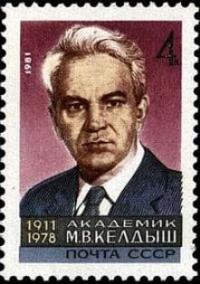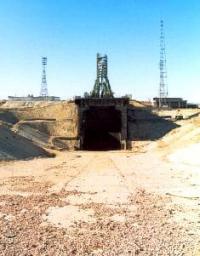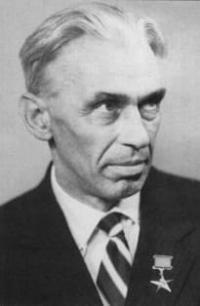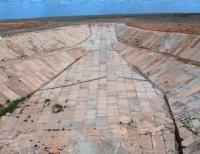Вы здесь
Operation "Stadium" at Baikonur Cosmodrome.




Sightseeing at Baikonur Cosmodrome.
“Humanity will not remain on Earth forever, but in pursuit of light and space, it will first timidly penetrate beyond the atmosphere, and then conquer the entire circumsolar space. If people penetrate the solar system, manage it like a mistress in a house: will then the secrets of the world be revealed?
Not at all! Just as examining a pebble or shell will not reveal the secrets of the ocean. Heroes and daredevils will pave the first air routes: Earth - Moon orbit, Earth - Mars orbit and even further: Moscow - Moon, Kaluga - Mars.
There is no creator god, but there is a cosmos that produces suns, planets and living beings: there is no omnipotent god, but there is a Universe that controls the fate of all celestial bodies and their inhabitants."
Sergei Pavlovich Korolev.
Trip from Aralsk to Baikonur.
When the first photo of the launch of the famous “seven” appeared in the press several decades ago, the Soviet people gasped: they saw a pit in which the pantheon-tomb of Pharaoh Cheops easily fit! I remember a strategist friend of mine exclaimed:
“It’s crazy! What if you need to put a thousand missiles on alert? Then we’ll have to dig up the entire Soviet Union!”
But, as we now know, it didn’t come to that, and thousands of new pits were not required...
Championship at Baikonur?
The resolution of the Council of Ministers on the development of jet weapons was adopted on May 13, 1946. Its paragraph 9 reads: “Create a Jet Institute (Research Institute - 4) and the State Central Test Site for jet technology in the Ministry of the Armed Forces.”
At that moment, the construction of the first launch for an intercontinental ballistic missile was still very far away: the country had neither a design base, nor an industry capable of making launch equipment and missiles, nor personnel...
Construction of the launch site for the “seven” begins on May 5, 1950. Among the objects of the first stage, the tray for diverting the gas jet of the working cluster of first stage engines with dimensions stands out for its cyclopean scale: width in the middle part - 180 meters, depth on the side of the launch facility - 54 meters and length - 300 meters.
With the rocket hovering above the tray in an opening 15 meters wide at a height of 29 meters from the slope of the tray. Having skipped the mandatory geodetic survey stage, the Army Corps of Engineers is digging into the stubborn desert soil every day.
More than 1.0 million tons of soil are removed from the pit, 13,000 cubic meters of reinforced concrete structures are installed... Military builders almost every day see a stern man with a secret name walking around a giant construction site, in front of whom the generals are drawn to attention. He has no contact with the rank and file, but when his gas car slows down, the soldiers ask in unison:
- What will happen here, in this hole?
The mortally tired stranger jokes:
- Didn’t the commanders tell you? There will be a stadium here. For the World Cup!
Some people may have believed...
Now we can admit: the luminaries then had no special considerations when choosing a gas outlet tray. The designers from GPI-31, of course, talked with the “chief theorist” - Academician M. Keldysh, his colleague supervising the work at the start, Academician G. Petrov, and offered S. Korolev exactly that tray, the dimensions of which are given above. And things started to get worse.
But since no one knew what would happen to the foundation pit at the moment of the scorching impact of a jet of hot gases from rocket engines on it, the designers, to be on the safe side, included in the design of the tray the covering of its entire surface with slabs of heat-resistant cast iron.
It was expected, according to theorists, that up to 2.5 centimeters of the thickness of the slabs would be washed away by the gas jet at each launch. As always, from the very beginning there was no shortage of skeptics who doubted the need to dig pits for launches “all the way to the magma.”
Back in 1950, at NII-4, M. Tikhonravov’s group considered the problem of gas dynamics of the launch of “package” rockets (having a bunch of engines in the first stage) - the same one that was implemented in 1957 in the R-7 rocket by Korolev.
And although the 1954 design assignment did not include scientists working on the launch complex, the “worm of doubt” was already actively sharpening their bright minds: after all, they were already proposing their own version of the launch, a more complex design, but 10 times smaller in size.
Korolev, having familiarized himself with their considerations, said:
- Academician Petrov from NII-1 knows better what kind of start is needed! We set up the start with a single-slope reflector, as he suggests. And after the first launches we'll see...
However, already in 1951, from NII-4, a report was sent to authorities with an alternative launch option and - more importantly - containing a proposal from senior engineer Yan Koltunov to replace the cast iron reflector plates with slabs of refractory concrete on liquid glass with fireclay filler - in 8 times cheaper material, not to mention its incredible durability in the gas stream from rocket engines.
President from the Commander-in-Chief.
In 1954 - 1955, Koltunov began studying the wave structure of a gas jet (torch from engines) and soon came to the disappointing conclusion that the existing ideas about the jet emanating from a bunch of engines as a single heated stream were erroneous.
It is more realistic to consider individual torches from each engine in a “package”, which immediately reduces the total length of the gas jet many times – 7 times for the R-7 rocket – and reduces its destructive effect on the lining of the gas outlet tray by the same amount.
Finding himself in Baikonur in the spring of 1957, Koltunov reported his thoughts to Marshal of Artillery N. Krylov and Chief Designer S. Korolev, who replied:
- Let's wait for the results of the first launches. After them there will be a meeting of the State Commission - you will report there!
Then Koltunov, right there at the test site, submits a rational proposal to replace the cast iron slabs with concrete ones, which is implemented at the first start by replacing the slabs of the side walls of the gas outlet tray.
Korolev does not forget about Koltunov, and after the first launch of the “seven” he organizes a meeting with him of the luminaries who arrived at the test site: M. Keldysh, G. Petrov, prof. A. Kosmodemyansky and others. They silently listen to the senior engineer’s considerations and order:
- Prepare the minutes of the meeting, we will sign it!
Yan Ivanovich compiles the text in a “secret” notebook, not forgetting to emphasize that we are talking about “a radical reduction in the size of gas outlet trays, which provides cost savings of 300 million rubles only for this type of start.”
The document is signed and sent to all interested authorities. But when Koltunov later sees the protocol, for some reason he finds no traces of his participation in the work on the document...
Although the naive engineer is robbed by luminaries in broad daylight, he also sets out his thoughts in reports on the work he performs at the test site, which are sent from NII-4 to the “authorities”. Reviews from specialists are received by the institute, addressed to the head of the research institute, General A. Sokolov, who wrote a resolution on one of them:
“Shouldn’t we nominate the head of the work, Ya. Koltunov, for the Lenin Prize?” And he immediately instructs us to “work on the list of authors,” which within a week reaches a “critical mass” of 12 people. Alas, things never came to the point of the emergence of a “new squad” of laureates...
Meanwhile, at Baikonur and Plesetsk, where more and more new launch sites similar to his type for the R-7 are being built, a strange situation is developing: everyone, including Korolev, knows about the advantages of Koltunov’s “small-sized” launch, but no one does anything!
Two years pass like this. And suddenly the incredible happens: the new commander-in-chief of the Strategic Missile Forces, Marshal of Artillery Mitrofan Nedelini, finds out about Koltunov’s proposals, slamming his fist on the table, and takes the head of NII-4, General Sokolov, by the throat:
“Where is Koltunov’s easy start?” I ask you, as a communist?
“So it was necessary to first test its design at the start of the “seven”,” the frightened general babbles in response.
- “Seven” has been flying for a long time! “And you keep calving,” the marshal growls at the careless subordinate. I give you a week and a half time: if you don’t do it, you’ll go to court!
Sokolov communicates via helicopter with the head of Baikonur, General Konstantin Gerchik:
- Kostya, save me! My shoulder straps are burning!
Gerchik rushes to the main builder of the cosmodrome, General A. Shubnikov:
- Can you do it in two weeks? I won’t forget it until the grave!
And he responded:
-Are you crazy? This will take me at least four months!
Koltunov, who observed this whole “circus,” declares:
- Give me a team of installers and draconian powers - and we will do everything ourselves!
And a miracle happens: all the launch equipment is manufactured directly at the test site and mounted at a distance of 8 meters from the exit of the rocket engine nozzles at an angle of 37 degrees to the vertical. In one week! By coincidence - by May 9, 1959.
Koltunov is required to sign that he “guarantees that nothing will happen to the country’s only ICBM launch and the missile launched from it.” For the next launch of the “seven”, dozens of fire engines are pulled together from all over the training ground;
At a distance of 3 kilometers on the observation deck, military prosecutors are shifting impatiently, ready in the event of an accident to give the “culprit” Koltunov an appropriate sentence.
But the launch remains intact, and General Gerchik gives Yan a gift from the Commander-in-Chief - a “Rocket” watch with a personalized inscription. But even after this triumph, the path of Koltunov’s proposals into the notorious “practice” turns out to be by no means strewn with roses.
According to Jan, there were so many obstacles that even mammoths would have thrown away their tusks long ago! But he fought, promoting his technical solutions (“shortened” launches) - first in relation to M. Yangel’s R-12 and R-14 missiles, and then R-16. Then - to V. Chelomey’s rocket.
Once, before retiring, an economist from the Ministry of General Machinery secretly whispered to Yan that his proposals saved money in the industry by “several billion rubles.” These are the fruits of his many years of labor at the landfills, for 6-8 months a year, eating rusty sprat and washing it down with water and sand from the tap...
- But did the Motherland at least somehow appreciate your work? - I ask Yana.
“But of course,” he answers.
– Once the director shook my hand; There were also diplomas and a bonus of five hundred rubles. Yes, I almost forgot: I also have the Order of the Badge of Honor. That's it, it seems, that's all...
Authority and photos:
Vladimir Polivanov, full member of the Academy of Theoretical Problems. “Air Transport” No. 22 (3022), June 2003. Aerospace publication of the Economic Newspaper Publishing House.
https://www.koltunov.ru/Literature/StatyaVozdTrans200306_OperationStadion.htm







